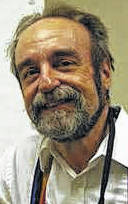
When I was young, I spent my most peaceful moments meandering through a little patch of trees and meadow near my lower-class suburban home in Austintown, Ohio.
As William Wordsworth wrote, we enter our lives “trailing clouds of glory.”
Many were the days I gazed at the sunlight on the trees in perfect and profound innocence and marveled at its beauty. I chased the pollywogs in a little stream and dug in the soil to unearth the cicadas that lay sleeping.
In 1963, when I was 11, I briefly glimpsed the partially eclipsed sun through the clouds and trees above my head.
My wise and gentle fourth grade teacher described a total eclipse of the sun that would occur in 2024. I would be 71 years old. “I hope you will be there to see it,” she said quietly to the class. “I surely won’t.”
I fancied myself, doddering and weak, being helped out of my house in Austintown to see the event.
A question obsessed me for months afterward. Would I be alive in 2024? It was the first time I imagined my own demise.
I knew practically nothing about death, pollywogs or solar eclipses. I knew not that the sun was an immense hydrogen bomb, the light from which gave life to planet Earth and its unfathomable complexity of creatures.
As I grew older, I learned much about the sun. Cascading from the sun and lost in its glare is the solar corona, a Latin word that means “crown” or “garland.” It is as if the solar monarch wore a shimmering crown, a manifest but usually invisible symbol of our daystar’s royal power over life on our planet.
During an eclipse, the moon comes between the Earth and the sun. The moon’s oval shadow casts itself on a thin band of Earth’s surface. On April 8, the shadow will hurtle at over 1,000 mph, starting in the southern Pacific Ocean and ending in the Atlantic northeast of Canada. For the first time in 200 years, parts of Ohio lie along the shadow’s path.
The sun’s garland of power is invisible because of the sun’s blinding glare. During the solar eclipse’s totality, we will stand in the moon’s dark shadow.
Consequently, we may briefly see the sun’s atmosphere, its corona, blasting away from the sun at over a million or more mph.
As the coronal gasses rapidly rise from the sun’s simmering surface, their temperature increases from 10,000 degrees F to more than 100,000 degrees.
As we stand briefly in the shadow, day becomes night, and old Sol’s iridescent crown shines as bright as the full moon. During an eclipse’s totality, the invisible becomes gloriously visible.
How can anything so powerfully violent be so delicately beautiful? How do I find the words to describe that beauty?
During totality, the moon appears as a dark void, blacker than black, a tunnel into infinity.
To the ancients, the moon was a goddess. For a moment, the dark lady moon overthrows the royal sun and seizes his crown. We see her surrounded by what becomes a celestial garland. Its bright glory is festooned with feather boas bejeweled with ruby explosions called solar prominences.
During my first totality in 1991, I imagined myself for a moment on the African savanna and the mountains of China 10,000 years ago. A giant monster was trying to swallow the sun, the godly giver of light and life. What terror our ancient forebears must have felt — and what joy as the monster spit the sun back out.
Then, I was floating in a small Polynesian boat in the middle of the Pacific Ocean as the sun and the moon made love and gave birth to the stars. And I felt the Polynesians’ unspeakable joy.
And then I was a child again, experiencing the beauty and the terror of a partially eclipsed sun in my little copse of trees. But now I saw the source of life and light and its radiant atmosphere on a universal scale.
I was bathed in revelation, drunk with terror and relief and joy.
Of course, the monster regurgitated the sun, and old Sol returned to its blinding glory. The feelings slowly faded as I returned to more mundane endeavors.
Thanks to my first total solar eclipse, a fragment of my youthful wonderment returned. I will carry a bit of that childlike awe with me all the rest of my days.
In 1963, 2024 seemed a lifetime away. As I thought about my own demise, it seemed an unfathomable distance away.
I am now 60 years closer to life’s final curtain, and it will fall that much sooner.
But on April 8, if the weather gods permit, I will again watch the sun die and be reborn. And I will remember that fourth grade teacher who revealed the universe to me.
I will imagine an 11-year-old reading these lines and hope that I have done the same for her, them, or him as we stand together, our faces bathed in regal light, in the shadow of the moon.
Tom Burns is the former director of the Perkins Observatory in Delaware.

